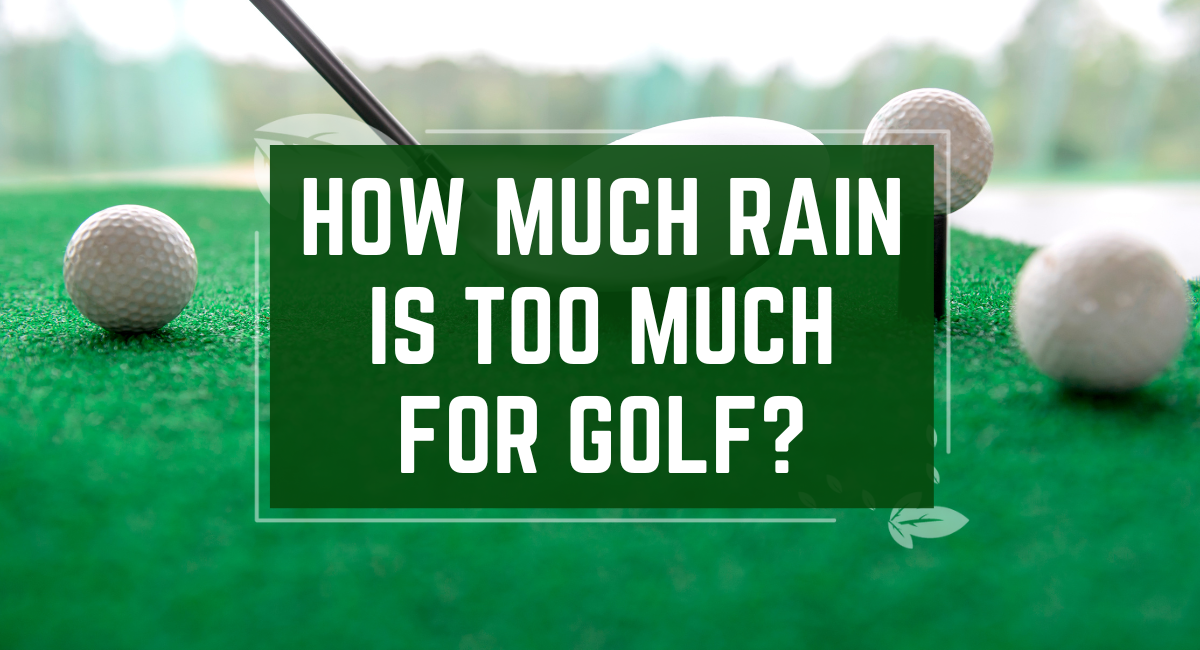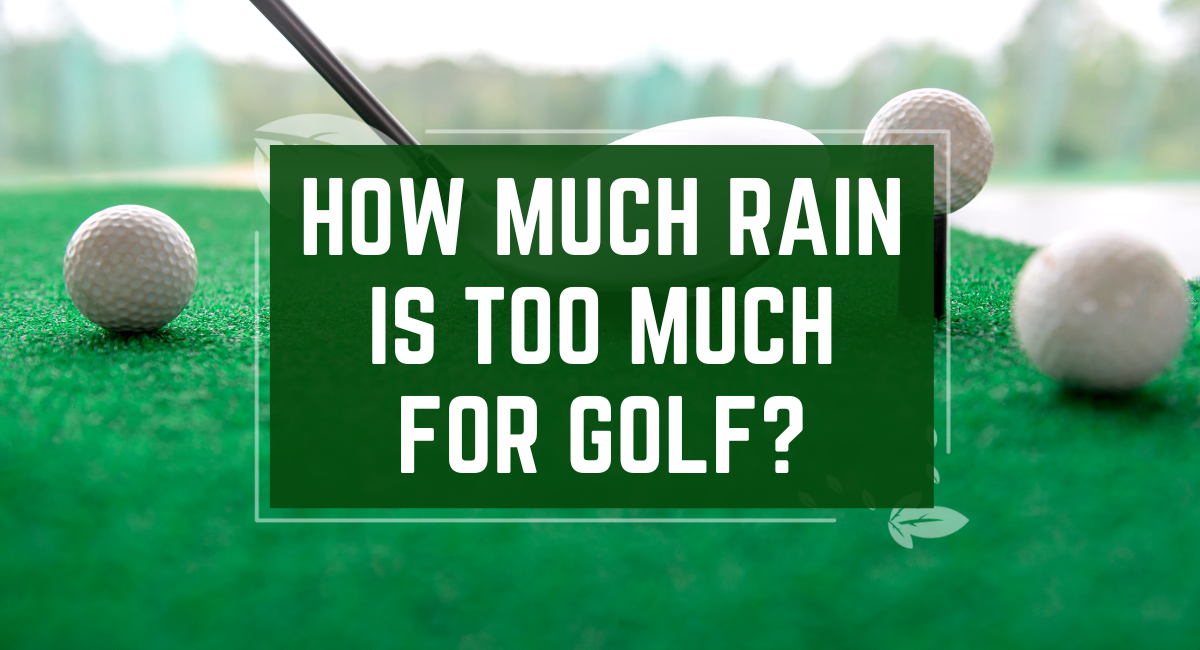How Much Rain is Too Much for Golf?


You’re on the golf course, the crisp morning dew still fresh under your feet, the green as inviting as ever. You’ve been planning this round all week, and now you’re all set to tee off. Suddenly, you feel it. A single drop. Then another. Before you know it, it’s a downpour. But how much rain is too much for golf? Is it just a challenging drizzle or an impossible deluge?
The subtle dance between the elements and the sport is an equation many golf enthusiasts like you have pondered. You see, golf isn’t merely a game of clubs and balls; it’s a symphony that marries skill, precision, strategy, and indeed, the ever-fluctuating weather. It’s not uncommon for golfers to find themselves questioning, “Should I swing away amidst the rain, or should I call it a day?”
This comprehensive guide is designed specifically for you. It will delve into the details of rainfall’s impact on the game, helping you discern when it’s time to keep swinging and when it’s wise to pack your clubs away.
How Much Rain is Too Much for Golf?
Rain impacts every facet of golf, from tee shots and long irons to chips and putts.
-
The Greens: Rain can drastically alter the speed of the greens. A light shower might slow them down a touch, but heavy rainfall can make them waterlogged and extremely slow. If the rain is causing standing water on the greens, your balls won’t roll effectively, turning your smooth putt into a spluttering stop-start affair. This is clearly not conducive to a fair or enjoyable game.
-
The Fairways: As for the fairways, a damp surface might result in less roll, potentially robbing you of those extra yards that a nicely hit drive can give you. But if there’s so much water that your ball plugs or even gets lost in casual water, then you’re battling against more than just your fellow players.
-
The Bunkers: Bunkers are another point to consider. A little rain can actually help by compacting the sand, making it easier to strike the ball cleanly. But if the bunkers turn into mini ponds or the sand becomes overly compacted, it’s certainly time to call it a day.
-
Visibility: On a simpler level, if the rain is coming down so hard that you can’t see where your ball lands, then it’s definitely too wet to play!
Do golf courses close when it rains?
Answer: No, golf courses generally do not close when it rains. Many golfers actually prefer playing in the rain because the course is less crowded. In fact, many golf courses offer specials or discounts on green fees for players willing to brave the elements.
Some golf courses will let players finish their rounds, but not allow any new players on the course.
That said, some courses may close if there is an extreme weather event such as a tornado or hurricane. But in general, golfers don’t have to worry about bad weather closing down their local course.
General Tips for Playing Golf in the Rain
1. Keep your imagination open
You may think you’ll hit the ball worse in the rain, but don’t let that thought limit your potential. It’s all too easy to be overwhelmed by negative thoughts when getting ready to play in wet conditions; instead, take a positive approach! Imagine yourself hitting beautiful shots over and over again, and chances are - you will!
2. Hit it low
Even if you usually like to swerve balls left or right off the fairway (or even out of bounds), try cutting down on such maneuvers today. Hitting long is key when experiencing heavy rainfall; to do this, aim lower than usual to help the ball maximize its distance.
3. Aim left or right
If you have a strong preference for how to hit the ball, being in the rain might force you into playing your weaker side. Don’t dare fighting it! If you’re having trouble hitting off-center shots perfectly straight, aim slightly to the right of where you’d usually like and trust yourself to swing evenly and eventually work back to center (or vice versa).
4. Putt like it’s dry out
Golf balls move more slowly on wet surfaces; unfortunately this also makes them much harder to predict mid-air. To avoid missing short putts - simply stand up straighter than usual when taking your swing. By stepping away from the ball instead of bending down (as you would on a normal putting green), it’ll be much easier to judge its speed and distance.
5. Swing like it’s dry out
While your ball will indeed travel slower when wet, the surface you’re playing on will still make an impact on how fast or slow it moves across the green (or fairway). If you usually hit the ball pretty quickly, take shorter swings today - especially if you’re in standing water. The last thing you want is the ball picking up mud mid-flight!
6. Use winter gear
If time isn’t pressing, consider trying out some winterized golf attire instead of just regular rain gear. This way you can ensure that your number one enemy - moisture - doesn’t have a snowballs chance in hell of getting anywhere near your body. Waterproof gloves, hats and pants are available for purchase at most pro shops - so why not try them out?
7. Just have fun!
Sure it may be wet and cold outside, but that’s no reason to stay inside - especially when you can still enjoy a great game of golf in almost any conditions! With a little imagination and lots of determination you’ll find yourself playing with more confidence than ever before; eventually even the harshest downpour will seem like child’s play.
What to Wear When Playing Golf in the Rain

When the weather gets nasty, many people won’t think about going out for a round of golf. In fact, they may even refuse to do so if it’s raining or snowing outside. However, don’t let a little rain stop you from enjoying your favorite pastime. With the right clothing and equipment, you can have a great time playing even in less-than-ideal conditions.
Let’s look at some ways that you can stay warm and dry when playing golf in the rain:
Wear Waterproof Footwear
Golfing in the rain is a lot easier if you have waterproof footwear. This means using shoes or boots that are designed with materials such as rubber and Gore-Tex which repel water. They may be more expensive than your regular sneakers, but they will keep your feet dry and comfortable all day long. Also, look for footwear with good traction to prevent slipping over on slick surfaces.
Wear Socks That Will Keep Your Feet Dry
Moisture can get into your shoes and wet your socks no matter how great the shoe’s outer design is at repelling water. Moisture doesn’t just make your feet feel uncomfortable; it can lead to problems like athlete’s foot and fungus between toes. To avoid this issue, opt for socks made with materials like polypropylene and nylon. These fibers wick sweat away from your feet so it can keep them dry on the inside. Also, choose ones that are absorbent to soak up any water that gets into your shoes over the course of the day.
Wear Insulated Pants
When you’re golfing in rainy conditions, it’s easy for water to seep into your clothing and ruin it. On top of this, outerwear that is too lightweight might not offer enough protection against wind or cold temperatures that could lead to discomfort. To avoid this problem, wear insulated pants which will help keep you warm even if they get wet. They also come with pockets where you can store supplies like handwarmers or a dry towel to help you stay comfortable when the weather gets bad.
Wear a Waterproof Jacket
You need something to keep your core warm even if it’s nasty outside, and an insulated jacket is a great choice. To be truly waterproof, look for options made with materials like Gore-Tex or eVent that will repel rain instead of absorbing it. You can also get jackets that come with pockets where you can stow away items like extra golf balls in case yours get wet from falling into puddles on the course.
How to Adjust Your Golf Swing When It’s Raining
The weather doesn’t always cooperate with our plans to go out and play a quick 9 holes after work. Sometimes it is raining so much that you wouldn’t dare take your clubs outside. Whatever the case maybe, you’re going to have to learn how to play better golf in the rain if you want to improve your game. Here are some tips on how you can adjust your golf swing when playing in wet conditions:
The first tip we’ll share is about what club should be used for hitting off of the tee box (the most important shot in golf). According to Golf Tips Magazine, the ball won’t travel as far or as high when the ground is wet. Therefore, it’s best to use an iron off of the tee box so you can keep your ball flight low and let it roll as far as possible after impact.
Another tip about how to adjust your golf swing for rainy days is putting some extra weight on the back foot during your address position. This will help generate some additional power by creating more weight tension at your rear foot at the moment of truth, just prior to exploding through impact with your driver. As always, make sure that you have a solid grip before taking aim at the flagstick. A firmer grasp on the club will allow you to place spin on the ball if necessary, which leads into our last point.
You can put backspin on the ball when it’s wet by making a sweeping motion with your hands and wrists during your takeaway and downswing. This will make the ball bounce off of the fairway or rough and roll towards the hole instead of finding its way into ponds, streams or even worst…golf course bathrooms!
That’s all you need to know about how to adjust your golf swing when it’s raining. We hope this helps improve your game during these tough weather conditions.
FAQ
Does rain ruin golf clubs?
No, rain doesn’t ruin golf clubs. However, while rain does not ruin golf clubs, it can definitely have an impact on their performance. Wet weather makes the clubface slick, which means it is more difficult to make accurate shots. In addition, wet grass can cause the club to become mired in mud and bog down, making it harder to swing. As a result, playing in the rain can be quite challenging and may lead to lower scores.
it’s important to take proper care of your clubs so they last longer. Here are a few tips for keeping your golf clubs in good condition even when it’s raining:
-
Store your clubs in a waterproof bag or cover when they’re not in use.
-
Wipe down your clubs after every use, making sure to dry them off completely.
-
Use a good quality club wax to protect them from the elements.
-
If your clubs get wet, dry them off as soon as possible and then apply some wax. This will help prevent rusting.
-
Make sure to wipe off all the mud after you hit a ball into a muddy area. This will help prevent mud from accumulating on your club and making it harder to swing.
-
Clean your clubs with a damp cloth or chamois leather, if possible. If they are badly muddied, use a soft bristle brush and some soap and water instead. Dry them thoroughly afterwards using a towel.
-
Wipe down your grips regularly using an anti-dirt grip solvent spray, which will help keep dirt from building up between the grooves of the handle of your clubs.
In conclusion, even though rain doesn’t ruin golf clubs per se, it can definitely have an impact on their performance when it comes to making accurate shots and swinging the club smoothly.
Proper care should be taken in order to keep your clubs in good condition, which includes cleaning them with a damp cloth or chamois leather if possible and wiping down the grips using an anti-dirt grip solvent spray regularly.
Lastly, make sure you store your golf clubs in a waterproof bag or cover whenever you’re not using them so they don’t get wet and stay away from muddied areas on the course so as to prevent mud from accumulating on your clubface and affecting its performance.

Patrick Mahinge is a golf enthusiast and the chief editor of Golf Pitches, a website that delivers innovative and data-driven golf product reviews. With a keen eye for detail and a passion for the sport, Patrick has transformed Golf Pitches into a trusted source of information for golfers worldwide. Patrick's expertise lies in his ability to dissect complex golf equipment and present his findings in an engaging, easy-to-understand manner. His reviews are not just informative, but they are also backed by rigorous data-driven methodologies, making them a trusted resource for golf enthusiasts and professionals alike..

